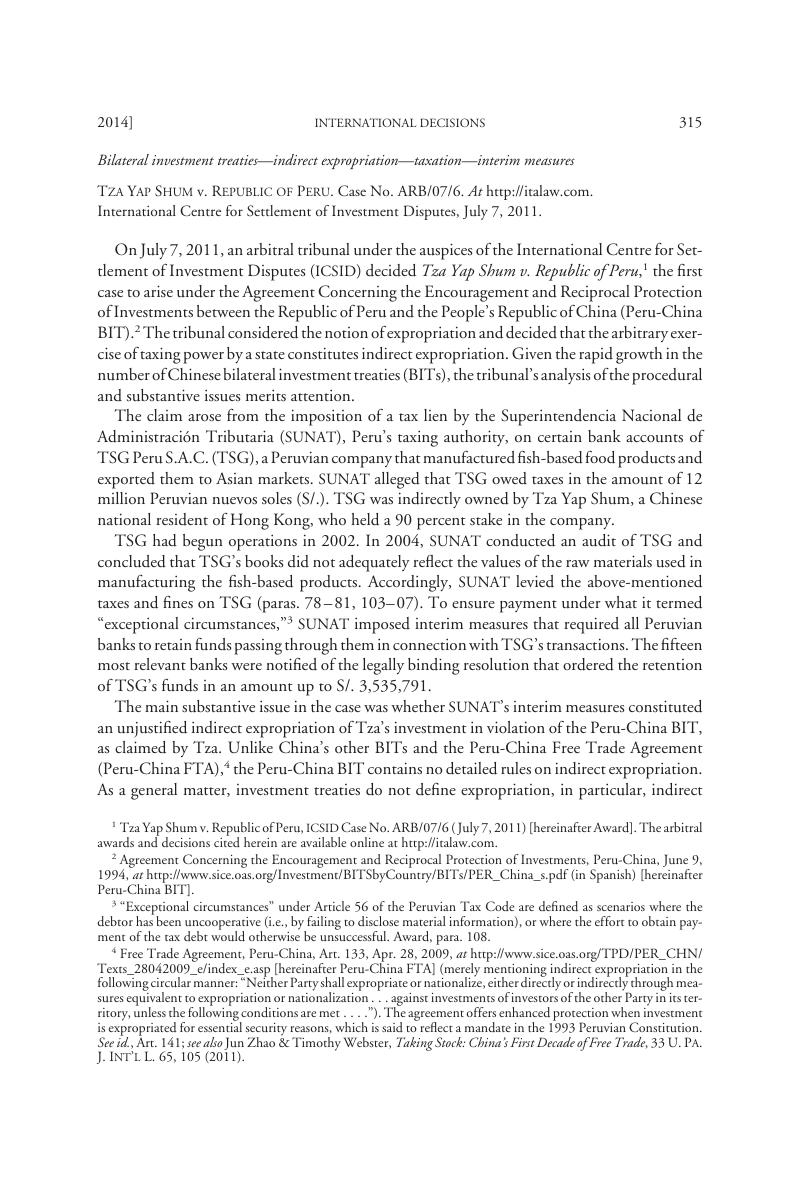Article contents
Tza Yap Shum v. Republic of Peru
Published online by Cambridge University Press: 20 January 2017
Abstract

- Type
- International Decisions
- Information
- Copyright
- Copyright © American Society of International Law 2014
References
1 Tza Yap Shum v. Republic of Peru, ICSID Case No. ARB/07/6 (July 7, 2011) [hereinafter Award]. The arbitral awards and decisions cited herein are available online at http://italaw.com.
2 Agreement Concerning the Encouragement and Reciprocal Protection of Investments, Peru-China, June 9, 1994, at http://www.sice.oas.org/Investment/BITSbyCountry/BITs/PER_China_s.pdf (in Spanish) [hereinafter Peru-China BIT].
3 “Exceptional circumstances” under Article 56 of the Peruvian Tax Code are defined as scenarios where the debtor has been uncooperative (i.e., by failing to disclose material information), or where the effort to obtain payment of the tax debt would otherwise be unsuccessful. Award, para. 108.
4 Free Trade Agreement, Peru-China, Art. 133, Apr. 28, 2009, at http://www.sice.oas.org/TPD/PER_CHN/Texts_28042009_e/index_e.asp [hereinafter Peru-China FTA] (merely mentioning indirect expropriation in the following circular manner: “Neither Party shall expropriate or nationalize, either directly or indirectly through measures equivalent to expropriation or nationalization... against investments of investors of the other Party in its territory, unless the following conditions are met....”). The agreement offers enhanced protection when investment is expropriated for essential security reasons, which is said to reflect a mandate in the 1993 Peruvian Constitution. See id., Art. 141; see also Zhao, Jun & Webster, Timothy, Taking Stock: China’s First Decade of Free Trade, 33 U. Pa. J. Int’l L. 65, 105 (2011)Google Scholar.
5 Award, para. 156 & n.113 (quoting Glamis Gold, Ltd. v. United States, para. 356 (NAFTA Ch. 11 Arb. Trib. June 8, 2009) (reported by Stephan W. Schill at 104 AJIL 253 (2010))).
6 Quoting LG&E Energy Corp. v. Argentine Republic, ICSID Case No. ARB/02/1, Decision on Liability, para. 191 (Oct. 3, 2006), 21 ICSID Rev. 269 (2006), 46 ILM 40 (2007).
7 Biwater Gauff (Tanzania) Ltd. v. United Republic of Tanzania, ICSID Case No. ARB/05/22, para. 779 (July 24, 2008).
8 Peru-China BIT, supra note 2, Art. 4(1)(d) (prohibiting expropriation without compensation).
9 Peru-China FTA, supra note 4, Annex 9, para. 3(a).
10 Citing the Counter memorial of the Defense, paras. 256–65.
11 E.g., Saluka Invs. v. Czech Republic, Partial Award, para. 255 (UNCITRAL Arb. Trib. Mar. 17, 2006).
12 Peru-China FTA, supra note 4, Annex 9, para. 5.
13 Metalclad Corp. v. Mexico, ICSID Case No. ARB(AF)/97/1, paras. 106–07 (NAFTA Ch. 11 Arb. Trib. Aug. 30, 2000), 40 ILM 36, 50 (2001) (reported by William S. Dodgeat 95 AJIL 910 (2001)); Middle E. Cement Shipping & Handling Co. v. Arab Republic of Egypt, ICSID Case No. ARB/99/6, para. 153 (Apr. 12, 2002).
14 Peru-China BIT, supra note 2, Art. 4(1).
15 Pinard, Laurie A., Comment, United States Policy Regarding Nationalization of American Investments: The People’s Republic of China’s Nationalization Decree of 1950 , 14 Cal. W. Int’l L.J. 148 (1984)Google Scholar.
16 Anderlini, Jamil & Dyer, Geoff, Beijing Accused of Launching Attack on Private Enterprise, Fin. Times, Nov. 26, 2009, at 7 (London ed.)Google Scholar; see also Geoff Dyer, Mine Crackdown Ignites Concern over Land Grab, id.; Chuin-Wei Yap, Beijing Aims to Enlarge Role of State-Owned Coal Giants, Wall St. J., Nov. 29, 2013, at A 12; Davis, Bob, China’s State-Owned Sector Gets a New Boost, Wall St. J., Feb. 24, 2014, at A2 Google Scholar.
17 Peru-China BIT, supra note 2, Art. 4(1); Peru-China FTA, supra note 4, Art. 133(1).
18 Higgins, Rosalyn, The Taking of Property by the State: Recent Developments in International Law, 176 Recueil des Cours 259, 271 (1982 III)Google Scholar.
19 Peru-China FTA, supra note 4, Annex 9, para. 4.
20 The tribunal in Lauder noted that the European Court of Human Rights had “held that a ‘formal’ expropriation is a measure aimed at a ‘transfer of property’, while a ‘de facto’ expropriation occurs when a State deprives the owner of his ‘right to use, let or sell (his) property.’” Lauder v. Czech Republic, para. 200 (UNCITRAL Arb. Trib. Sept. 3, 2001) (quoting Mellacher v. Austria, 169 Eur. Ct. H.R. (ser. A) at 4, para. 44 (1989)). The tribunal in Nykomb Synergetics went even further. Even if the investment became worthless, it held, “[t]he decisive factor for drawing the border line towards expropriation must primarily be the degree of possession[,] taking or control over the enterprise the disputed measures entail.” Nykomb Synergetics Tech. Holding AB v. Latvia, SCC Case No. 118/2001, para. 4.3.1 (Stockholm Ch. Comm. Dec. 16, 2003).
21 Peru-China FTA, supra note 4, Annex 9, para. 4.
22 Id., para. 3(b).
23 Oppenheim’s International Law §407, at 916 (Robert Jennings & Arthur Watts eds., 9th ed. 1992).
- 1
- Cited by


